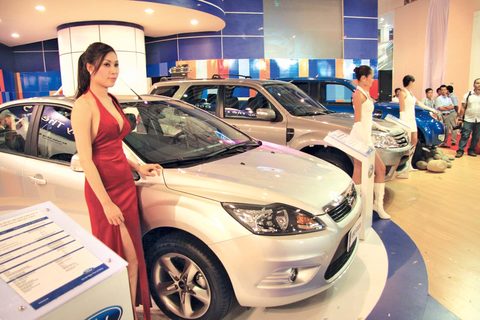
It is predicted that the volume of imported cars will increase considerably in Viet Nam this year when the tax on imports from ASEAN members to the country is reduced to 30 per cent of the car value. — Photo baodautu.vn
Vietnamese customers spent US$165 million to buy at least 7,000 imported cars in January at an average value of $23,570 each, the General Statistics Office (GSO) reported.
Imports increased by 19.7 per cent in volume and 12.2 per cent in value in January compared with the same period last year, the GSO said.
A representative of a Toyota agent in HCM City told Nguoi Lao dong (The Labourer) that since the last few months of 2016 until now, sales increased but not by an abnormal level. In January, during the pre-Tet (Lunar New Year) festival, people’s demand for buying new cars witnessed a marked increase, resulting in a scarcity of cars in the market.
In particular, while the sale of several vehicles was at a normal level, with some even declining in January, the new generation Fortuner imported from Thailand, priced from VND981 million to nearly VND1.15 billion, could not meet demand. Although agents asked customers to sign contracts first, in addition telling them they would receive the car in April or May, customers still agreed, the representative said.
Nguyen The Hung, director of KYLIN-GX668 Trade JSC, said local manufacturing of automobiles had reduced due to the effect of import tax on completely built-up units from ASEAN, which was being reduced regularly and was expected to be zero per cent by 2018.
Hung used Toyota as an example. The firm previously had five locally assembled models including Vios, Fortuner and Innova, but now it announced it would only produce one or two key models while the remainders would be imported.
Hung said the reduction in locally-assembled cars would certainly result in a decrease in domestic production and increase in completely built-up units. He said this was the trend of the future because domestic production had been not developed much, even as it had to compete with imported cars which enjoyed preferential tax.
“Meanwhile, the importers have a much easier time than the automakers because they can receive money immediately and update new models continuously, not having to rush into assembling,” Hung said to The Labourer.
As for the trend of imported cars, he said five and seven-seater vehicles from Thailand and Indonesia were the most favourable segments. In addition, the growth of imported cars with engine displacement below 2,000cc was promising thanks to the adjustment of special consumption tax since last July.
According to the calculations of businesses, with the reduction of import tax from 40 per cent to 30 per cent on cars from ASEAN under the ASEAN Trade in Goods Agreement in 2016-2018, it is predicted that by 2018 when the import tax becomes zero per cent, the prices may be decreased by 20-25 per cent compared with the current rates.
Due to the attraction of a strong cut in price by 2018, many auto businesses feel the trend of buying imported cars will not see a significant increase in 2017. The Vietnam Automobiles Manufacturers’ Association has forecast that the 2017 sales volume will be some 10 per cent higher than that of 2016.
The country imported nearly 113,600 units of completely built-up cars worth $2.3 billion in 2016.
Thailand is the leading exporter of cars to Viet Nam with 34,366 units. It is followed by India, the Republic of Korea and China, with 22,000 units, 20,204 units and 10,989 units, respectively. — VNS